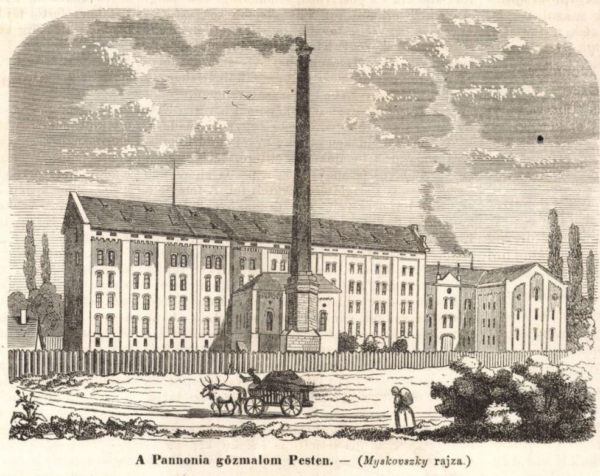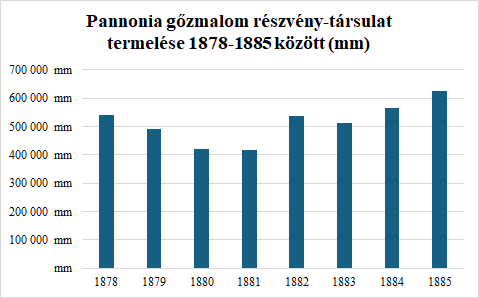Pannonia mill

The history of the steam mills is intertwined with the history of the capital: although the steam mills were established before the unification of Buda, Pest and Óbuda in 1873, their development was influenced by the development of the capital and its economic role. The establishment of the steam mills was made possible by the favourable transport conditions created by the Danube steamship and the agricultural boom in the middle of the century, which resulted from the urbanisation of European cities. Population growth led to a greater demand for grain, which meant that there was also an adequate outlet for it. The succession of steam mills had the advantage of being steam-driven, allowing them to be sited freely, as they did not need water or wind to operate. However, the steam engine required a considerable amount of water to operate the steam mills, which is why they were built close to the Danube.
The so-called "high milling" method, which was widespread in Hungary, was as follows: the grain was first taken from the warehouse to the mill, where it was cleaned of major impurities and the husk in the milling machine. The task of the 'tarar' was to clean the wheat grain before it went to the wheat classifier, which was able to sift out the defective grains. The thresher was responsible for filtering out the kernels and the brushing machine for removing the dust. The last operation before milling was conditioning, during which water equivalent to 2-3% of the weight of the wheat grains was added to the wheat. This was followed by a resting period and then the cleaned wheat was subjected to repeated crushing to obtain a fine flour. To obtain a larger grain size, it was milled into flour using roller mills or roller pairs.
The mill was built in 1863 by the Pannonia Steam Mill Joint Stock Company. It was the second Pest-based joint-stock milling company in Budapest. It was founded with the participation of wholesale trading houses from Pest (D. Herzfelder and his sons, Márk Hirschler and his sons, Enoch Kern J.'s sons and Mór Wahrmann and his sons) and produce merchants (J. F. Basch, Mór Flesch, Jakab Lányi and József Ullmann). The mill was built on the site in the old Water Street, which is the area bounded by the present-day Carpathian Street, Ipoly Street, Pannonia Street and Victor Hugó Street.
In its first decade of operation, the mill achieved significant results. During the first decade, production capacity increased significantly, from 240 thousand mm in 1866 to 560 thousand mm in 1875. As a result, the mill was able to produce for export (Germany, England, Brazil, Switzerland, etc.) and had a flour deposit in Prague. This is linked to the fact that the first machines for the mill were supplied by the Ruston mill in Prague.
In the mid-1870s, the only minor problem was the flooding of the cellars and courtyard of the farm for 35 days. During this period, production was interrupted.

In the first half of the 1880s, like the other mills in the capital, it faced economic difficulties. Competition from abroad forced the mill to reduce production, and it was running at a loss during these years. This was reflected in production and profits. For example, profits, like production, showed a significant break in the first half of the decade, which only started to improve from the second half of the decade:
- 104588 Ft
- 1186 Ft
- 234011 Ft
- 163703 Ft
- 170732 Ft
As the mill did not overcome the problems it faced, it became completely unprofitable. In 1895, it was absorbed by the Elizabeth Steam Mill Company and ceased to operate as a separate company.
Sources
Pannonia Steam Mill Company. Online website: http://remlac.hu/angyalfold_htk/13angyalfold_htk__cimekszerint/pannoniautca53/pannoniautca53.html. Last download date: 30 November 2024.
Great Hungarian Compass 1874-1895.
Press material 1868-1895.
Date of foundation: 1863
Date of cessation: 1894
Founders: D. Herzfelder and sons, Mark Hirschler and sons, J. Enoch Kern sons and Mór Wahrmann and sons, J. F. Basch, Mór Flesch, Jakab Lányi and József Ullmann
Securities issued:
| Pannonia mill |
Decisive leaders:
1874-1891 | Mór Wahrmann |
1892-1895 | Zsigmond Gold |
Main activity: cereal milling (wheat, barley, rye)
Seats:
1874-1895 | Budapest Váczi út, Kárpát-utca 5. |
Author: Róbert Szabó
Date of foundation: 1863
Founders: D. Herzfelder and sons, Mark Hirschler and sons, J. Enoch Kern sons and Mór Wahrmann and sons, J. F. Basch, Mór Flesch, Jakab Lányi and József Ullmann
Decisive leaders:
1874-1891 | Mór Wahrmann |
1892-1895 | Zsigmond Gold |
Main activity: cereal milling (wheat, barley, rye)
Main products are not set
Seats:
1874-1895 | Budapest Váczi út, Kárpát-utca 5. |
Locations are not set
Main milestones are not set
Author: Róbert Szabó
Pannonia mill

The history of the steam mills is intertwined with the history of the capital: although the steam mills were established before the unification of Buda, Pest and Óbuda in 1873, their development was influenced by the development of the capital and its economic role. The establishment of the steam mills was made possible by the favourable transport conditions created by the Danube steamship and the agricultural boom in the middle of the century, which resulted from the urbanisation of European cities. Population growth led to a greater demand for grain, which meant that there was also an adequate outlet for it. The succession of steam mills had the advantage of being steam-driven, allowing them to be sited freely, as they did not need water or wind to operate. However, the steam engine required a considerable amount of water to operate the steam mills, which is why they were built close to the Danube.
The so-called "high milling" method, which was widespread in Hungary, was as follows: the grain was first taken from the warehouse to the mill, where it was cleaned of major impurities and the husk in the milling machine. The task of the 'tarar' was to clean the wheat grain before it went to the wheat classifier, which was able to sift out the defective grains. The thresher was responsible for filtering out the kernels and the brushing machine for removing the dust. The last operation before milling was conditioning, during which water equivalent to 2-3% of the weight of the wheat grains was added to the wheat. This was followed by a resting period and then the cleaned wheat was subjected to repeated crushing to obtain a fine flour. To obtain a larger grain size, it was milled into flour using roller mills or roller pairs.
The mill was built in 1863 by the Pannonia Steam Mill Joint Stock Company. It was the second Pest-based joint-stock milling company in Budapest. It was founded with the participation of wholesale trading houses from Pest (D. Herzfelder and his sons, Márk Hirschler and his sons, Enoch Kern J.'s sons and Mór Wahrmann and his sons) and produce merchants (J. F. Basch, Mór Flesch, Jakab Lányi and József Ullmann). The mill was built on the site in the old Water Street, which is the area bounded by the present-day Carpathian Street, Ipoly Street, Pannonia Street and Victor Hugó Street.
In its first decade of operation, the mill achieved significant results. During the first decade, production capacity increased significantly, from 240 thousand mm in 1866 to 560 thousand mm in 1875. As a result, the mill was able to produce for export (Germany, England, Brazil, Switzerland, etc.) and had a flour deposit in Prague. This is linked to the fact that the first machines for the mill were supplied by the Ruston mill in Prague.
In the mid-1870s, the only minor problem was the flooding of the cellars and courtyard of the farm for 35 days. During this period, production was interrupted.

In the first half of the 1880s, like the other mills in the capital, it faced economic difficulties. Competition from abroad forced the mill to reduce production, and it was running at a loss during these years. This was reflected in production and profits. For example, profits, like production, showed a significant break in the first half of the decade, which only started to improve from the second half of the decade:
- 104588 Ft
- 1186 Ft
- 234011 Ft
- 163703 Ft
- 170732 Ft
As the mill did not overcome the problems it faced, it became completely unprofitable. In 1895, it was absorbed by the Elizabeth Steam Mill Company and ceased to operate as a separate company.
Sources
Pannonia Steam Mill Company. Online website: http://remlac.hu/angyalfold_htk/13angyalfold_htk__cimekszerint/pannoniautca53/pannoniautca53.html. Last download date: 30 November 2024.
Great Hungarian Compass 1874-1895.
Press material 1868-1895.